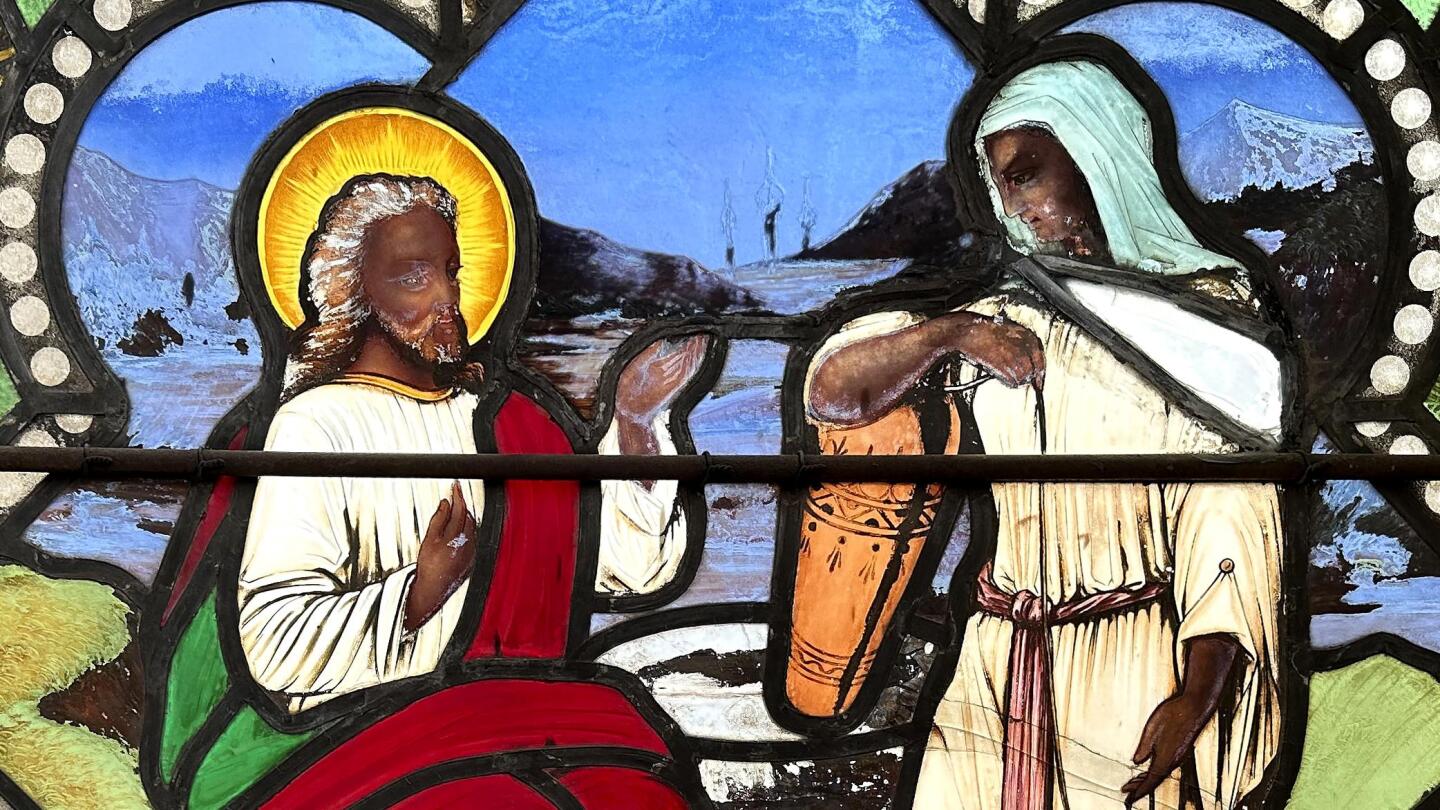
Stained glass window shows Jesus Christ with dark skin, stirring questions about race in New England
A nearly 150-year-old stained-glass church window showing a dark-skinned Jesus Christ interacting with women has been rediscovered in a Rhode Island church. The artwork is stirring questions about race, the slave trade and the place of women in 19th century New England society. Experts say the...
“This window is unique and highly unusual,” said Virginia Raguin, a professor of humanities emerita at the College of the Holy Cross in Worcester, Massachusetts, and an expert on the history of stained-glass art. “I have never seen this iconography for that time.”
The 12-foot tall, 5-foot wide (3.7 meters by 1.5 meters) window depicts two biblical passages in which women, also painted with dark skin, appear as equals to Christ. One shows Christ in conversation with Martha and Mary, the sisters of Lazarus, from the Gospel of Luke. The other shows Christ speaking to the Samaritan woman at the well from the Gospel of John.
The window made by the Henry E. Sharp studio in New York had largely been forgotten until a few years ago when Hadley Arnold and her family bought the 4,000-square-foot (371-square-meter) Greek Revival church building, which opened in 1830 and closed in 2010, to convert into their home.
When four stained-glass windows were removed in 2020 to be replaced with clear glass, Arnold took a closer look. It was a cold winter’s day with the sunlight shining at just the right angle and she was stunned by what she saw in one of them: The human figures had dark skin.
“The skin tones were nothing like the white Christ you usually see,” said Arnold, who teaches architectural design in California after growing up in Rhode Island and earning an art history degree from Harvard University.
The window has now been scrutinized by scholars, historians and experts trying to determine the motivations of the artist, the church and the woman who commissioned the window in memory of her two aunts, both of whom married into families that had been involved in the slave trade.
“Is this repudiation? Is this congratulations? Is this a secret sign?” said Arnold.
I've heard those who believe that Jesus was black, but it's interesting that someone made this back in 1878 in Rhode Island.
But does it depict a Black Jesus? Arnold doesn’t feel comfortable using that term, preferring to say it depicts Christ as a person of color, probably Middle Eastern, which she says would make sense, given where the Galilean Jewish preacher was from.
Others think it’s open to interpretation.
“To me, being of African American and Native American heritage, I think that it could represent both people,” said Linda A’Vant-Deishinni, the former executive director of the Rhode Island Black Heritage Society. She now runs the Roman Catholic Diocese of Providence’s St. Martin de Porres Center, which provides services to older residents.
“The first time I saw it, it just kind of just blew me away,” A’Vant-Deishinni said.
This was largely forgotten for more than a century until the church was bought by someone wanting to make it into a home. They're looking to give it to a museum or some other institution so it can be studied further.
The window was commissioned by a Mary P. Carr in honor of two women, apparently her late aunts, whose names appear on the glass, Arnold said. Mrs. H. Gibbs and Mrs. R. B. DeWolf were sisters, and both married into families involved in the slave trade. The DeWolf family made a fortune as one of the nation’s leading slave-trading families; Gibbs married a sea captain who worked for the DeWolfs.
Both women had been listed as donors to the American Colonization Society, founded to support the migration of freed slaves to Liberia in Africa. The controversial effort was overwhelmingly rejected by Black people in America, leading many former supporters to become abolitionists instead. DeWolf also left money in her will to found another church in accord with egalitarian principles, according to the research.
Another clue is the timing, Arnold said. The window was commissioned at a critical juncture of U.S. history when supporters of Republican Rutherford B. Hayes and their Southern Democrat opponents agreed to settle the 1876 presidential election with what is known as the Compromise of 1877, which essentially ended Reconstruction-era efforts to grant and protect the legal rights of formerly enslaved Black people.
Any thoughts?
